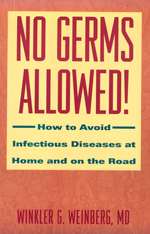Review of "No Germs Allowed"

Author(s): Winkler G. Weinberg, M.D.
Published: July 1, 1996, Rutgers University Press, ISBN: 0813522811
 by Elsie Y. Smith, Associate Professor of Biology
by Elsie Y. Smith, Associate Professor of Biology
March 62, 2005 -
At the time this book was written, Dr. Winkler G. Weinberg was Chief of Infectious
Diseases for the Southeast Permanente Medical Group and the director of a consortium
for research on infectious diseases. He lives near Atlanta, Georgia where he is a
practicing physician specializing in the treatment of infectious diseases.
Dr. Weinberg has written a very straight forward, easily read book addressing
infectious agents encountered in our daily routines, as well as those encountered
via specific professions and world travel. His language meets the technical expectations
of biologists and other scientists while being understandable to those outside the scientific arena. In addition to identifying the various ways one may become infected with microbes and other parasites, he offers specific, practical suggestions for prevention and treatment. His advice concerning food preparation and storage are especially
helpful considering the enormous number of cases of food infection and food poisoning
occurring annually in the U.S.
The book is divided into four sections; 1) infections encountered in daily living, 2) infections resulting from contact with environmental agents , 3) infections obtained from contact with other people, and 4) persons especially susceptible to infection. Each section offers suggestions for protection against infection as well as recommendations for treatment. He identifies specific symptoms of common infectious diseases and alerts the reader to those that signal severe problems. Although many of the recommendations for protection and treatment can be implemented by the reader himself, Dr. Weinberg is careful to identify situations in which expert medical prophylaxis and/or treatment is warranted or absolutely essential.
Section 2 contains an especially well written warning relative to world travel, specifically travel in underdeveloped countries. The reader will learn how to travel
with protective medications, what to avoid with respect to intake of food and water,
how to get proper medical coverage and treatment in foreign countries and what
official agencies in the USA should be contacted for up-to-date information regarding
required or suggested vaccinations. Appendix A of the book outlines the current
recommended vaccination schedule for U.S. citizens.
Knowing that a significant percentage of potential readers are at increased risk
for infections due to pre-existing medical conditions such as heart, lung, liver or
kidney disease, he includes special warnings and precautions. Women who are pregnant
and those with compromised immune systems would certainly benefit from the
information and advice he provides. He also offers advice to those scheduled to enter the hospital for surgery and tells all hospitalized patients how they can be proactive with respect to proper aseptic treatment.
It is very rare to find a single publication that incorporates so much specific and accurate information about current infectious diseases in humans. It is equally rare to find one written by a medical doctor at a level that all adult readers can understand.
Reading the book is much like going to the doctor without having to pay for an office visit. This is a book you should buy and keep at your fingertips.

